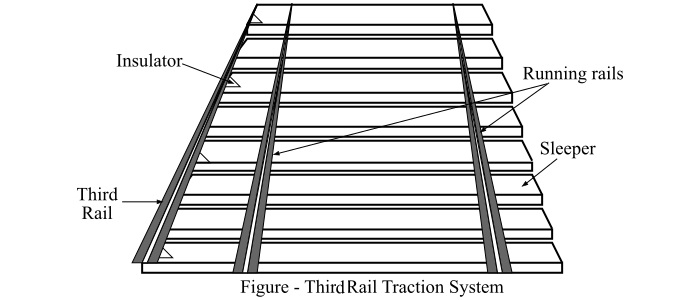
 Data Structure
Data Structure Networking
Networking RDBMS
RDBMS Operating System
Operating System Java
Java MS Excel
MS Excel iOS
iOS HTML
HTML CSS
CSS Android
Android Python
Python C Programming
C Programming C++
C++ C#
C# MongoDB
MongoDB MySQL
MySQL Javascript
Javascript PHP
PHP
- Selected Reading
- UPSC IAS Exams Notes
- Developer's Best Practices
- Questions and Answers
- Effective Resume Writing
- HR Interview Questions
- Computer Glossary
- Who is Who
What is Third Rail Traction System? – Advantages and Disadvantages
What is Third Rail Traction System?
A third rail is a method of providing electric power to an electric train through a semi-continuous rigid conductor placed along-side or between the running rails of a railway track.
The third rail system uses an additional rail, called as conductor rail for supplying electrical power to the train. On most of the traction system, the conductor rail is placed on the sleeper ends outside the running rails, but in some cases a central conductor rail is used. The conductor rail is supported on ceramic insulators or insulated brackets, typically at intervals of 3 meters.
The third rail is used in a mass transit or rapid transit system which has alignments in its own corridors, fully or almost fully segregated from the outside environment. Generally, the third rail is used in DC traction systems.

The figure shows a DC third rail traction system with the location of the current rail in relation to the running rails. The trains have a metal contact block called shoe which make contact with the conductor rail or third rail. The traction current is returned to the generating station through the running rails.
The conductor rail is usually made of high conductivity steel and the running rails have to be electrically connected using wire bonds or other devices to minimize the resistance of the electric circuit.
The conductor rails have to be interrupted at level crossings and at the crossovers and the ramps are provided at the ends of the sections to give a smooth transition to the train shoe.
Advantages of Third Rail Traction System
The third rail traction system has the following advantages over the overhead system −
Third rail system is cost-effective, i.e. the cost of the third rail is lower than that of the overhead conductor. As in the third rail system, no structures for carrying the overhead contact wires are required.
The electric third rail system is less affected by natural disasters.
Third rail system is more suitable for installation in tunnels with smaller clearance than overhead conductive wire systems.
Third rail system reduces the maintenance workload. This is because, the subway third rail does not need to be erected under tension and hence is not prone to breakage accidents. Even in the event of a failure, the scope is smaller and the reliability is higher.
In the third rail traction system, it is easier to take protective measures against the electromagnetic pollution.
Disadvantages of Third Rail Traction System
The following are the disadvantages of the third rail traction system −
In the third rail traction system, the presence of an electrified rail makes it hazardous for a person to fall into it.
The third rail system has the risk of pedestrians from walking onto the tracks at level crossings.
The end ramps of the conductor rails present a practical limitation on speed due to the mechanical impact on the shoe. In practice, 160 kmph is considered the upper limit in the third rail system operation.
The top contacts in the third rail systems are prone to accumulation of snow and ice which can interrupt the operation.
Due to the gaps in the conductor rail at level crossings and junctions, it is possible for a train to stop in a position where all its shoes are in gaps, so that no traction power is available. In this position, the train is said to be gapped and a following train is brought up behind the train to push it on to the conductor rail or a jumper cable is used to supply enough power to the train to get one of its contact shoes back on the third rail. This gives the minimum length of multiple unit on a line.

